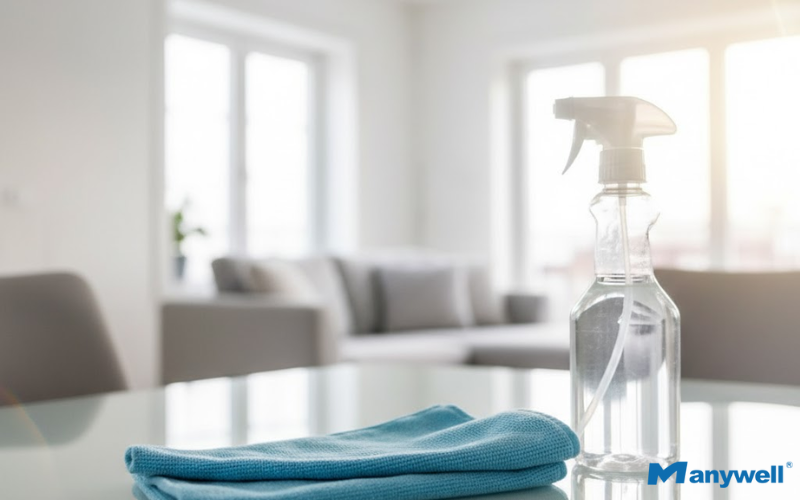
Cleaning glass sounds simple: spray and wipe, right? But many methods leave streaks. And most of the time, the issue isn’t dirt — it is using the wrong fabric and wrong cleaner. Different cleaning fabrics and cleaners push moisture around rather than removing it.
This is why professional cleaners swear by DIY cleaners and microfiber cloths. According to a study published on Research Gate, microfiber cloths outperform non-woven cleaning cloths in removing organic soils. In this article, we will explain how to clean glass and mirrors and introduce Manywell’s microfiber solutions for streak-free results.
Choosing the Right Cleaner
Not every glass surface reacts the same way to cleaning products. Some window cleaners made with alcohol or ammonia can leave behind a dull film or dry too quickly, especially in warm spots. Others might cause dust to settle again soon after cleaning.
A simple mix of distilled water and a few drops of mild window cleaner usually gives better results. What works best depends on how often the surface collects fingerprints, grease, or everyday dust.
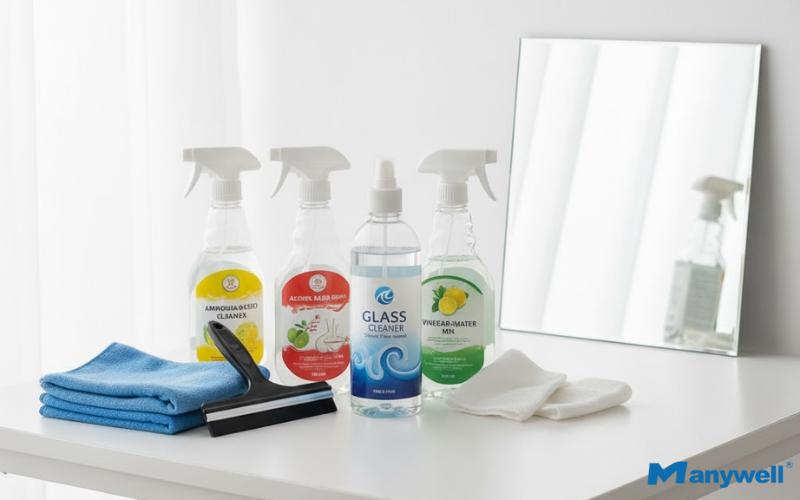
Here’s a quick guide to help compare different cleaning solutions:
| Cleaner Type | Best For | Pros | Cons | Streak Rating |
|---|---|---|---|---|
| White Vinegar | General cleaning, mineral deposits | Natural, affordable, cuts grime effectively | Strong smell | ⭐⭐⭐⭐⭐ |
| Rubbing Alcohol | Tough spots, ink stains, sticky residue | Dries fast, prevents streaks, strong cleaning power | Can be harsh on some coatings | ⭐⭐⭐⭐⭐ |
| DIY Solution (vinegar + water + soap) | Daily maintenance | Cost-effective, gentle, customizable | Requires mixing | ⭐⭐⭐⭐⭐ |
| Commercial Glass Cleaner | Quick cleaning | Convenient, pre-mixed | Often leaves residue | ⭐⭐⭐ |
| Ammonia-Based Cleaners | Heavy grime | Strong cleaning power | Can damage tinted windows | ⭐⭐ |
| Plain Water + Microfiber | Light dust, maintenance | Safe for all surfaces, eco-friendly | Not good for tough stains | ⭐⭐⭐⭐ |
For most homes and workplaces, a surfactant-based cleaner is the best choice. It breaks down grease while allowing even coverage and easy wiping. The idea is to clear away dirt and any cloudy film in a single pass, leaving the surface clean without soaking it. This kind of cleaner gives a balanced clean — effective but not harsh — which makes it a reliable choice for regular use.
How to Clean Glass and Mirrors of Windows Properly
Windows catch everything, from dust and rain spots to bits of pollution that are in the air. And over time, all that dirt makes the glass look dull and keeps the sun from coming through.
Cleaning them often keeps the rooms brighter and the glass clearer for longer. Here’s a simple way that works every time to clean glass and mirrors of windows properly.
Step 1: Remove Surface Dust
Always start dry. Use a soft microfiber cloth to lift off dust, pollen, or anything loose sitting on the surface. If you don’t do this step, you might get tiny scratches when you wipe with liquid later.

Check the window frames too. If there is dirt on the edges or sills, clean them first so it doesn’t get back on the glass. For those hard-to-reach places where dirt builds up, a damp cloth works well.
Don’t skip this step even if the window looks clean. Even when the glass looks clean, give it a quick once-over with a dry cloth. Static often pulls fine dust onto the surface, and once it mixes with cleaner, it leaves streaks. A quick dry wipe makes the real cleaning easier.
Step 2: Apply Cleaning Solution
Next, spray the cleaner you chose evenly over the glass. A few light sprays on each section will do. If you spray too much, you might get drips that dry before you can wipe them up, leaving water marks.
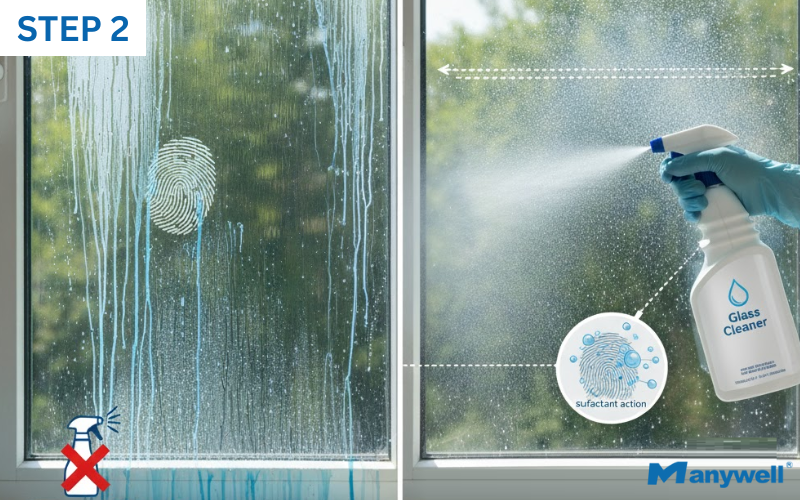
Pay more attention to places with fingerprints or grease. Give the cleaner a few seconds to work so that the surfactants can break up the dirt. This helps you get rid of dirt without having to scrub hard, which can hurt the glass coating.
Step 3: Wipe in Straight Lines
Use a clean microfiber cloth and move it in straight, overlapping lines. Vertical and horizontal motions give even coverage and prevent circular smears that scatter light. Always start from the top and move down to avoid recontaminating cleaned areas.
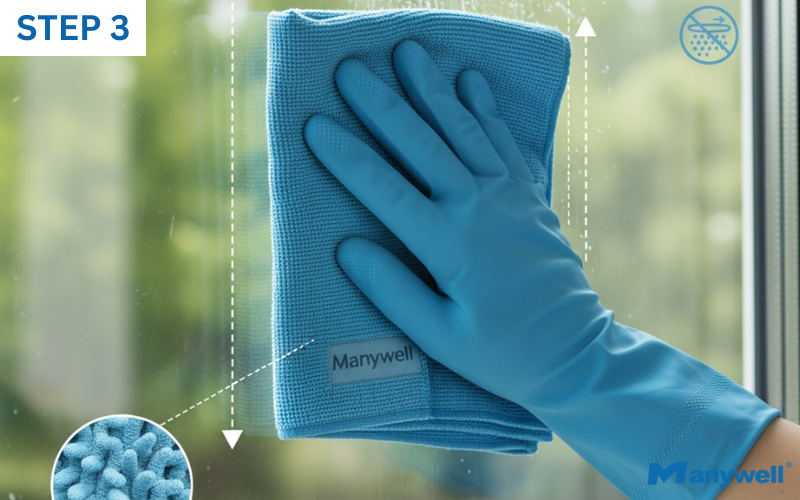
If your cloth becomes damp, switch to a dry section or grab another one. A wet cloth can leave behind streaks or lint, especially on larger windows. Keep your strokes consistent for a professional finish.
Manywell’s microfiber range is ideal here. Each cloth traps fine particles in its dense weave, lifting dirt rather than pushing it around. This small change makes a big difference in how clear your windows look after drying.
Step 4: Remove Moisture and Dry
Once you’ve cleaned the entire pane, use a squeegee to pull off excess liquid. Start from the top corner and drag down in a single motion, wiping the squeegee blade after every pass. This prevents streaks from forming as water collects.

After that, use a dry microfiber cloth for final touches. Gently buff the glass to remove any remaining moisture. Pay special attention to edges where droplets tend to hide.
Pro tip: Always keep one cloth for drying only. Mixing it with your cleaning cloth spreads moisture back on the surface. A dedicated drying cloth keeps the finish spotless and helps avoid dull streaks once the light hits.
Cleaning Windows: Glass and Mirrors Cleaning Tips
Mirrors need gentle care. They show streaks and water spots more than windows do.
Use cleaners that are safe for mirrors. Some products damage the reflective backing over time.
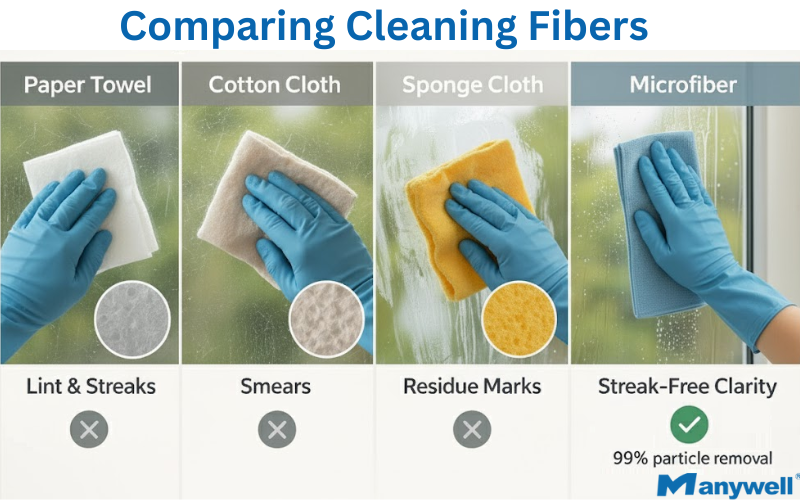
Skip the paper towels. They leave lint and create streaks. Research in the American Journal of Infection Control shows microfiber cloths clean better than cotton, sponge cloths, or paper towels.
For stubborn spots, use rubbing alcohol. Put a small amount on a soft cloth. Rub gently until the spot lifts. Don’t scrub hard, or you might scratch the surface. Try Manywell’s microfiber terry cloth for your mirrors. The fine fibers trap dirt without leaving residue.
Recommended Reading: How to Identify a High Quality Microfiber Towel?
How to Prevent Streaks on Glass and Mirrors
Streaks frustrate everyone who cleans glass. They usually come from wrong materials or bad technique. Use lint-free microfiber cloths to stop streaks before they start. Cotton and paper products shed fibers that stick to glass.
Wipe in one direction only. Don’t go back and forth. This moves dirt off the surface instead of spreading it. Always finish with a dry microfiber cloth. This final step removes moisture that could dry into streaks.
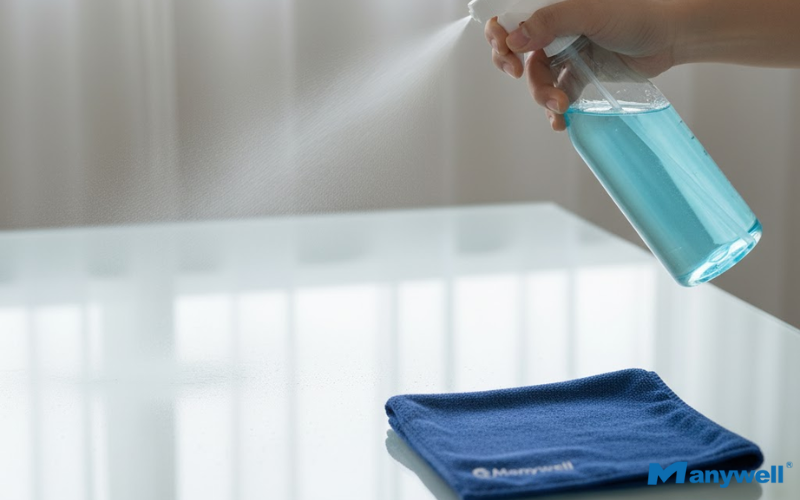
Never clean glass in direct sunlight. Heat makes your cleaner evaporate too fast. This leaves streaks behind.
Recommended Reading: Best Towel to Dry a Car Without Scratching: Complete Guide
Tips for Effective Cleaning & Streak-Free Finish
Even top-notch tools won’t produce excellent results if you use them negligently. How you clean is just as important as what products you select. Taking care of small things keeps streaks from forming, saves you time, and makes your glass shine longer.
Here are a few simple but useful tips that can help you in effective cleaning:
- To control, use a spray bottle. It lets you clean dirty spots without soaking the whole surface or wasting product.
- Select soft, absorbent cloths for wiping. High-quality microfiber can hold more water and dirt than cotton or paper towels.
- Instead of cold water, use warm water. Warm water makes sticky residue come off faster and makes cleaning easier, especially when using homemade solutions.
- Press down with moderate pressure when wiping. Excessive pressure smears dirt; insufficient pressure leaves marks behind. Use steady, even strokes.
- Do one section at a time. Cleaning a small area at a time prevents pre-maturation drying, which produces streaks.
These tips may seem small, but they make cleaning glass a lot easier when you do them all together. Using high-quality microfiber and cleaning in sections gives a clear, streak-free finish that lasts longer between cleanings.
DIY Glass Cleaner Recipes
Homemade glass cleaners are cheap, non-toxic, and easy to prepare. You can use simple ingredients found at home and make them without any dangerous chemicals. Below are three simple recipes to try at home.
Basic Glass Cleaner
This is the easiest and most versatile glass cleaner. It’s effective on windows, mirrors, and tabletops.
Ingredients:
- 1 cup water
- ½ cup white vinegar
- 1 tablespoon dish soap
Pour all into a spray bottle and gently shake before use. The dish soap removes dirt, and the vinegar dissolves grease. Spray lightly onto glass and clean with a microfiber cloth for a streak-free finish.
This cleaner is perfect for quick touch-ups. It’s gentle on most surfaces and leaves no residue. Use it on kitchen windows, bathroom mirrors, or any glass that requires instant cleaning.
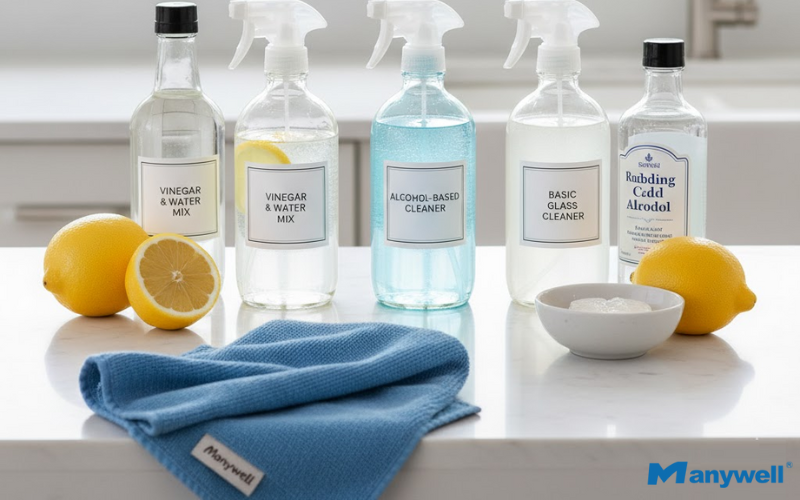
Streak-Free Formula
This mix gives a professional-level shine and dries quickly. The added alcohol speeds up evaporation, reducing water spots.
Ingredients:
- 1 cup water
- ½ cup white vinegar
- ½ cup rubbing alcohol
- 1 tablespoon dish soap
Combine the ingredients in a spray bottle and shake well. Spray on the glass, let it sit for 10–15 seconds, then wipe with a soft microfiber towel. Buff with a dry section for a spotless finish.
This formula is perfect for mirrors and indoor windows where streaks are more visible. For best results, store it in a cool, shaded area and use within one month.
Anti-Static Cleaner
This recipe goes a step further. It not only cleans but also helps keep dust away. The hair conditioner reduces static, which makes glass surfaces stay clean longer.
Ingredients:
- 2 cups warm water
- ¼ cup white vinegar
- 2 tablespoons dish soap
- 1 tablespoon hair conditioner
Mix all ingredients in a bowl of warm water, then pour into a spray bottle. Shake before each use. Spray evenly on the glass and wait for about two minutes before wiping. Use a microfiber cloth to clean, then dry remaining moisture with a chamois or dry towel.
You can also add 10–15 drops of essential oil if you like a fresh scent. Lemon adds brightness, while lavender gives a calm, clean smell. This recipe works great for living room windows and decorative glass panels.
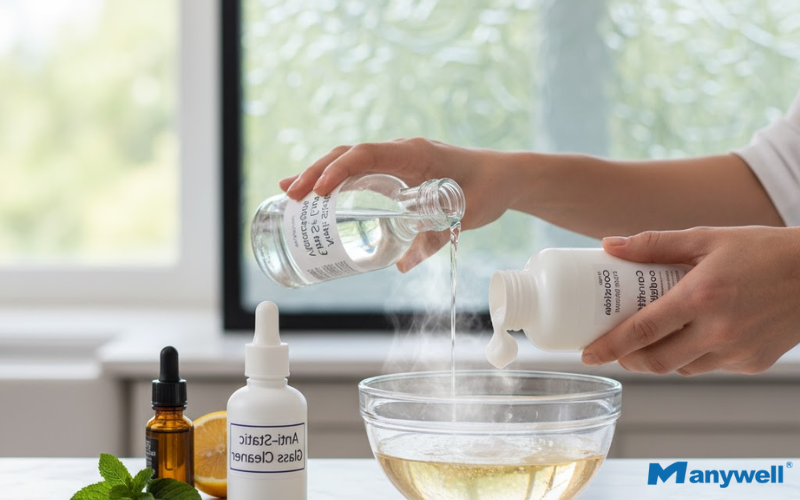
Green Cleaning Options
Eco-friendly cleaning protects your health and the planet. Traditional glass cleaners often have chemicals that pollute indoor air.
Microfiber cloths alone with water, can clean the majority of glass. A UC San Francisco study showed microfiber mops with detergent removed bacteria as well as cotton mops with disinfectant. Choose biodegradable, non-toxic solutions when you need extra power. Look for products with environmental certifications.

Reusable microfiber cloths eliminate paper towel waste as well. One effective cloth replaces hundreds of paper towels. Manywell’s tear-away cloth rolls offer a smart middle option. Each sheet tears off easily. You get the convenience of disposables with microfiber cleaning power.
Common Mistakes to Avoid
Even people who clean a lot make these errors. Here’s how to avoid them.
- Cleaning in Direct Sunlight: The heat makes the cleaner evaporate before you wipe it. This makes lines. Clean when it’s cloudy or in the morning or evening. Start cleaning on the side that is in the shade if you have to do it on a sunny day.
- Not Enough Cleaner: To get rid of dirt, glass needs a lot of solution. If you don’t use enough cleaner, you’ll keep wiping without making any progress. Put on enough to make the surface wet.
- Wrong Drying Tools: Newspaper leaves marks on glass. Paper towels that are cheap fall apart. Get some good microfiber cloths that are made for glass.
- Bad Wiping Methods: Dry cloths scratch glass. Wiping without a plan just moves dirt around. Make sure your cloth is always a little wet. Only wipe in one direction.
Professional Tools Make a Difference
Quality tools always show their worth the moment you start cleaning. A good cloth should leave glass clear after the first wipe — no streaks, no haze. Manywell’s microfiber products are built for that kind of result, whether you’re cleaning car windows, glass walls, or mirrors at home.
Each cloth is made with tightly woven, lint-free fibers that lift dirt instead of spreading it around. The texture helps you effectively clean both small and large areas without reaching for harsh chemicals. In most cases, you only need tap water or a mild cleaner in your bucket to get the job done.
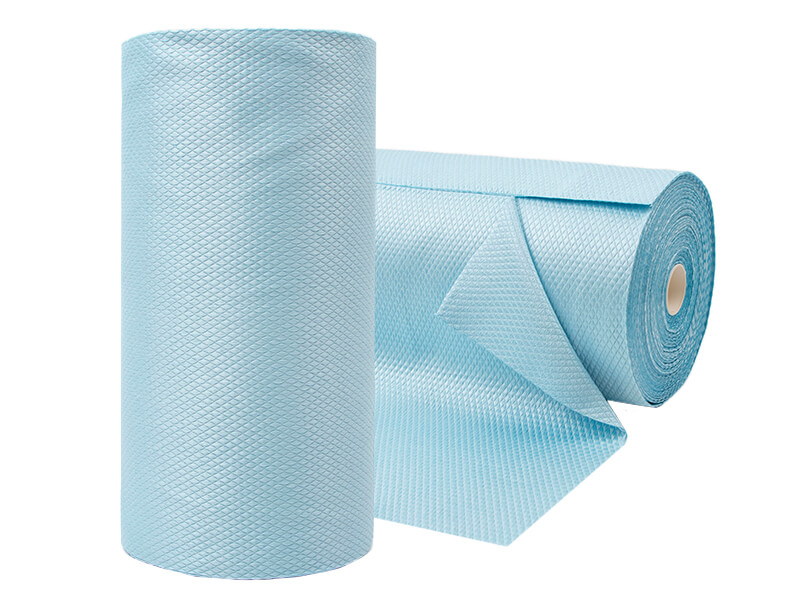
Hard water stains and greasy marks can be stubborn, but using a gentle circular motion helps loosen buildup without scratching the surface. The high absorbency of microfiber also means less water waste and fewer products needed — helping you save time while getting a spotless finish.
From everyday household cleaning to professional detailing, these cloths handle it all. Their durable weave stands up to hundreds of washes, staying soft and reliable. For those who want to clean efficiently and get rid of streaks for good, quality microfiber tools make all the difference.
Conclusion
When it comes to how to clean glass and mirrors, you don’t need special skills or costly products. Success comes from good tools and proven methods. Start with quality microfiber cloths and a simple cleaning solution.
Work across the surface in straight lines. Don’t use circles. Finish with a dry cloth to remove moisture. With these tips and the right tools, you can get professional results at home. A little effort makes a big impact on your living space!
Find Professional-Grade Cleaning Cloths at Manywell
Manywell is a reliable cleaning product manufacturer and supplier in China. Our microfiber cloths deliver spotless results on mirror and glass surfaces. Need a one-time use option? We also offer tear-away cloth rolls that are designed for simple, disposable cleaning use!
All of our products are customizable, giving you full control over design and specifications. Contact us or explore our collection to find the option that fits your cleaning style and space.




